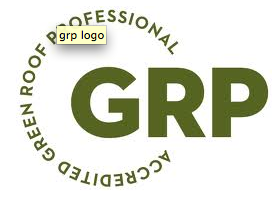The Green Roof Professional (GRP) certification system was developed by Green Roofs for Healthy Cities, a not-for-profit industry association working to promote and develop the market for the green roofs throughout North America.
 In addition to providing a professional accreditation program, the organization facilitates the exchange of information, supports research, and promotes the establishment of effective public policies. The organization presents Awards of Excellence to celebrate innovative professionals and organizes the annual CitiesAlive conference to develop supportive policies.
In addition to providing a professional accreditation program, the organization facilitates the exchange of information, supports research, and promotes the establishment of effective public policies. The organization presents Awards of Excellence to celebrate innovative professionals and organizes the annual CitiesAlive conference to develop supportive policies.
Green Roofs for Healthy Cities has been committed to developing a professional accreditation program to legitimize green roof designers and provide education to fill knowledge gaps and improve the quality of work.
In 2004, Green Roofs for Healthy Cities developed its first training course, Green Roof Design 101. It has since added Green Roof Design and Installation 201, Green Roof Waterproofing and Drainage 301, and Green Roof Plants and Growing Media 401. The classes are available in Toronto, New York, Atlanta, and Denver on select dates. They are each full-day courses recommended as a part of the GRP training program. The following half-day courses are also available, and count as continuing education credits:
· Advanced Green Roof Maintenance
· Introduction to Rooftop Urban Agriculture
· Green Walls 101: Systems Overview and Design (2nd Ed.)
· Integrated Water Management for Buildings and Sites
· Ecological Green Roof Design
· Green Infrastructure: Policies, Performance and Projects
· Green Roof Policy Development
Each course is accompanied by a course manual, which includes all the material on the accreditation exam.
Unfortunately, the accreditation process is rather expensive. Tuition for each full-day course is $399 USD and is accompanied by a course manual. Each course manual can be purchased for $199 USD separately for those who choose not to take the classes in person. The accreditation exam itself consists of 100 multiple-choice questions and lasts 2 hours. It costs $495 USD to enroll and cannot be taken online, but is only offered in Denver, Toronto, New York, and Chicago, incurring further transportation costs. In order to maintain GRP Certification, you must be a Green Roofs for Healthy Cities member ($160 USD annually), and renew your certification every 2 years. This involves completing a minimum of 16 continuing education credits, 8 of which must for GRHC related activities, and paying a renewal fee of $95 USD. Interestingly, each continuing education course is listed at 3.5 units, effectively forcing members to increase the number of classes they must take to maintain their accreditation. Some of the half-day courses can be taken online for $125 USD as part of the Living Architecture Academy.
While the accreditation process may be designed to increase the reliability of green roof designers, Green Roofs for Healthy Cities is also cashing in on the deal. The North American green roof industry grew by 115% in 2011, drawing many more interested professionals and increasing public awareness. Much like LEED in their field, GRHC monopolizes the accreditation process and effectively takes advantage of all the growth.
The existence of the certification is a double-edged sword: while it assures potential consumers that the professional hired has a sound informational backing, it also forces those who want to become green roofers to submit to the monopoly as it becomes the standard.
As a guerrilla green builder, EcoBrooklyn works with clients who seek the most cutting edge techniques. We reduce the net energy of each project by maximizing the use of natural and salvaged materials. The green roof methods taught in the GRP program adhere to the contemporary methodology involving plastics and other foreign materials. While we agree with the basic ideals driving GRHC’s mission (in that the application of green roofs is an essential component to reducing building impact and bettering the urban environment), we do not believe that adhering to the methods prescribed in the accreditation program are necessarily the only right way to build a green roof. In addition, as the organization grows, there is the danger that monetary and political pressures skew the curriculum towards supporting certain brands and materials which may not necessarily be the most ecologically friendly. The GRP curriculum is updated to include new knowledge, and we hope that GRHC’s updates will move towards greater net sustainability.
As it stands, the program is a good way for interested people to learn about green roofs as long as they allow themselves to expand on the ideas taught by GRHC. While we applaud Green Roofs for Healthy Cities’ organizational and promotional achievements, we hope that it does not become a prerequisite to legitimize oneself in the field but instead serves as a possible stepping-stone for professionals.
